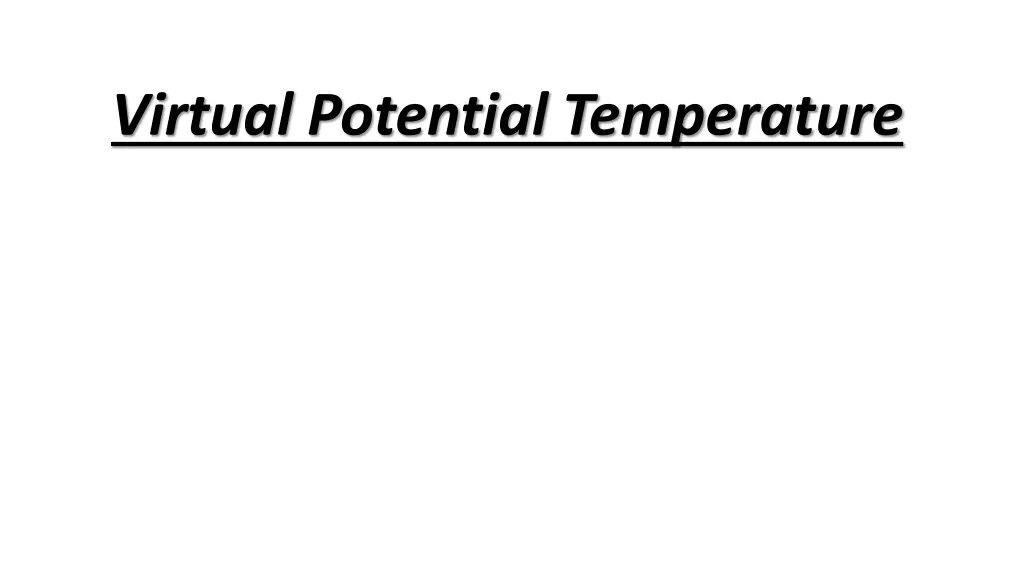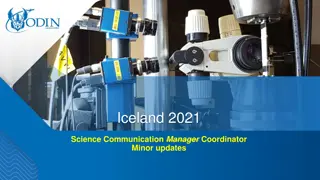
Understanding Virtual Potential Temperature and Mixed Layer Dynamics
Explore the concepts of virtual potential temperature and mixed layer dynamics in meteorology. Learn about potential temperature, virtual temperature, and their significance in atmospheric stability. Delve into the characteristics of the mixed layer, its turbulence drivers, and how it influences weather phenomena. Enhance your understanding of key atmospheric variables for better weather analysis and forecasting.
Download Presentation

Please find below an Image/Link to download the presentation.
The content on the website is provided AS IS for your information and personal use only. It may not be sold, licensed, or shared on other websites without obtaining consent from the author. If you encounter any issues during the download, it is possible that the publisher has removed the file from their server.
You are allowed to download the files provided on this website for personal or commercial use, subject to the condition that they are used lawfully. All files are the property of their respective owners.
The content on the website is provided AS IS for your information and personal use only. It may not be sold, licensed, or shared on other websites without obtaining consent from the author.
E N D
Presentation Transcript
Potential temperature : The potential temperature is the temperature that the parcel would attain if adiabatically brought to a standard reference pressure P0 usually (1000 mb) or (100 kPa). Potential temperature is a more dynamically important quantity than the actual temperature. This is because it is not affected by the physical lifting or sinking associated with the flow over obstacles. Potential temperature is a useful measure of the static stability of the unsaturated atmosphere. When v is constant, the atmosphere is statically neutral. When it decreases with elevation, the atmosphere is unstable to vertical motions, and convection . When it increases with elevation, the atmosphere is statically stable. Potential temperature perturbations potential temperature perturbation is defined as the difference between the potential temperature of the ABL and the potential temperature of the free atmosphere above the ABL. Virtual temperature (Tv) : Virtual temperature is the temperature at which dry air would have the same density as the moist air, at a given pressure. The virtual temperature of unsaturated moist air is always greater than the absolute air temperature. The suspension of cloud droplets in an air parcel, it always reduces the virtual temperature. Virtual potential temperature : Virtual potential temperature is similar to potential temperature in that it removes the temperature variation caused by changes in pressure. Virtual potential temperature is useful as a surrogate for density in buoyancy calculations and turbulence transport which includes vertical air movement.
the virtual potential temperature is only about 4 K warmer than the potential temperature, this difference is on the same order as the difference between the warm air rising in thermals and the surrounding environment.
Mixed Layer The turbulence in the mixed layer is usually convectively driven. Convective sources include heat transfer from a warm Earth surface and radiative cooling from the top of the cloud layer. The first situation creates thermals of warm air rising from the ground, while the second creates thermals of cool air sinking from cloud top. Both can occur simultaneously, particularly when cool stratocumulus topped mixed layer is being advected over the warmer ground. Even when convection is the dominant mechanism, there is usually wind shear across the top of the ML that contributes to the turbulence generation. This free-shear situation is more akin to CAT and is thought to be associated with the formation and breakdown of waves in the air known as Kelvin-Helmholtz waves. On initially cloud-free days, ML growth is tied to solar heating of the ground. Starting about a half hour after sunrise, a turbulent ML begins to grow in depth. This ML is characterized by intense mixing in a statically unstable situation where thermals of warm air rise from the ground (Fig 1.8). The ML reaches its maximum depth in late afternoon. he resulting turbulence tends to mix heat, moisture, and momentum uniformly in the vertical. Pollutants emitted from smoke stacks exhibit a characteristic looping as those portions of the effluent emitted into warm thermals begin to rise (Fig l.8). . High or middle overcast can reduce the insolation at ground level. This, in turn, reduces the intensity of thermals. On these days the ML may exhibit slower growth, and may even become non-turbulent or neutrally-stratified if the clouds are thick enough
The resulting profiles of virtual potential temperature, mixing ratio, pollutant concentration, and wind speed frequently are as sketched in Figure 1.9. Virtual potential temperature profiles. The virtual potential temperature is nearly adiabatic in the middle portion of the mixed layer (ML), and is super-adiabatic in the surface layer. At the top of the ML there is usually a stable layer to stop the turbulent eddies from rising further. When the layer is very stable so that the temperature increases with height, it is usually called capping inversion. This capping inversion can keep deep convection from developing thus restraining the domain of turbulence. It is called the entrainment zone because entrainment into the ML occurs there. Wind speeds Wind speeds are sub-geostrophic throughout the ML. The middle portion of the ML frequently has nearly constant wind speed and direction. Wind speeds decrease towards zero near the ground. resulting in a wind speed profile that is nearly logarithmic with height in the surface layer. Mixing ratios evaporation of soil and plant moisture from below, and the water vapor mixing ratio is nearly constant in the ML. The moisture decrease across the top of the ML is very pronounced and is often used together with potential temperature profiles to identify the ML top from rawinsonde soundings. tend to decrease with height, even within the center portion of the ML. This reflects the
Pollutant Pollutant ML while FA concentrations remain relatively low. Pollutants are transported by eddies such as thermals; therefore, the inability of thermals to penetrate very far into the stable layer means that the stable layer acts as a lid to the pollutants too. Trapping of pollutants below such an "inversion layer" is common in high-pressure regions and sometimes leads to pollution alerts in large communities. Most pollutant sources are near the earth's surface. Thus, pollutant concentrations can build up in the






















